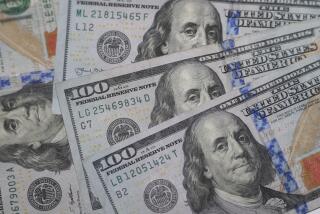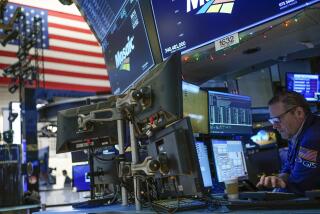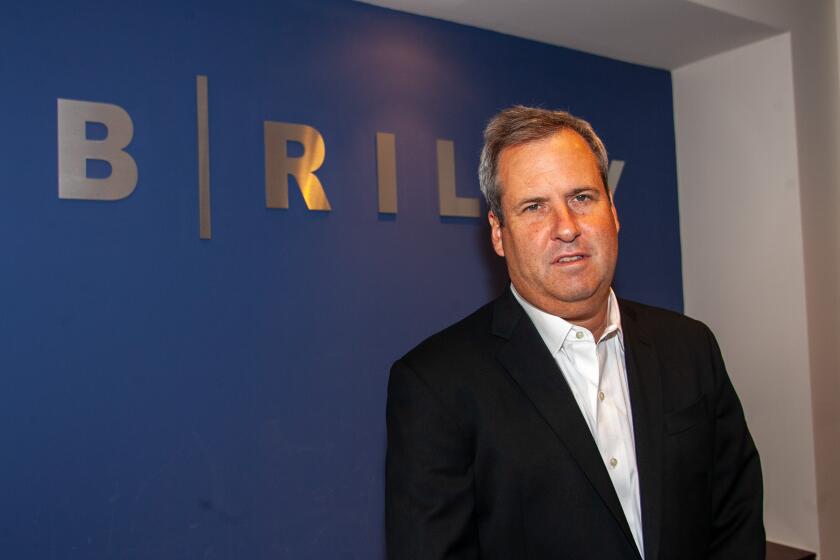After 3 Years of Losses, Stock Funds’ Biggest Challenge May Lie Ahead
War clouds are gathering. The economic outlook is murky. Oil prices are spiking. And stock mutual funds are coming off their third down year in a row.
In other words, fund managers say, it’s time for optimism.
“To predict a fourth losing year would be crazy,” said Douglas Foreman, who manages the TCW Galileo Aggressive Growth Equity and TCW Small Cap Growth funds in Los Angeles. “I don’t know what else can go wrong.”
Any turnaround, of course, would be warmly welcomed.
Despite a fourth-quarter stock market rally that lifted the average U.S. equity fund 5.9%, the loss for the year still was 22.6%, according to fund tracker Morningstar Inc. That was the worst performance since 1974 and about twice as bad as 2001, when the average fund slid 10.9%.
The last time stock funds endured three consecutive losing years was 1939-41.
“The third time was not charming,” said Don Cassidy, senior research analyst at Lipper Inc. in Denver.
There was almost nowhere for fund investors to hide in 2002, with each of the nine major Morningstar stock fund categories ending in the red. Large-cap growth, for instance, tumbled 27.7%, and even small-cap value, a big winner in 2001, lost 10.3%.
The market’s decline was so broad that among 27 stock fund sector categories, only two finished in the black: Precious metals funds -- traditionally seen as a haven during tough times -- soared 63% on average, and real estate funds gained 4.1%, helped by the allure of “hard” assets and by the hefty dividend yields paid by real estate investment trust stocks.
Among precious metals funds, which added to 2001’s 20.2% gain, leaders included American Century Global Gold and Evergreen Precious Metals, which soared 73% and 38.4%, respectively.
In the real estate sector, AIM Real Estate gained 8% and Cohen & Steers Special Equity returned 7.7%.
On the other end, technology sector funds were the worst performers for a second straight year, plummeting 43.1% on average and bringing their three-year average annualized loss to 37.6%.
Many of the most popular stock funds recorded double-digit losses in 2002. The $61-billion Fidelity Magellan fund, a common choice in 401(k) retirement plans, sank 23.7%, and the flagship Janus Fund, a symbol of the 1990s’ growth-stock market, dropped 27.6%. Both performed worse than the benchmark Standard & Poor’s 500 index, which had a negative total return of 22.1% for the year.
Even most conservative “value”-style stock funds ended in the red. American Funds’ Investment Company of America, for example, lost 14.5%; Vanguard Wellington fell 6.9%.
Among the few domestic funds gaining ground in 2002 were Yacktman Focused and Yacktman Fund, both managed by Donald Yacktman, which rose 15% and 11.4%, respectively. Yacktman, who tends to follow a “deep-value” approach, by the end of the third quarter had loaded up on such out-of-favor names as AOL Time Warner and Electronic Data Systems.
Winners among small-cap funds included Royce Special Equity, managed by Charlie Dreifus, which gained 15% for the year, helped by rallies in shares of companies such as athletic shoe maker K-Swiss and tire maker Bandag.
Not surprisingly, funds that actively bet against stocks, such as through “short” sales, again were big winners. Leaders included Prudent Bear, managed by David Tice, which surged 50.6%, and the Rydex funds that follow a bearish strategy.
Meanwhile, the average foreign stock fund lost 13.8% for the year. Foreign losses were cushioned by the weak dollar.
First Eagle SoGen Overseas, managed by the valuation-conscious team of Jean-Marie Eveillard and Charles de Vaulx, climbed 12.5%, topping the foreign fund list.
Emerging-markets funds weathered the downturn even better, losing 5.9% on average, as rising economies in countries such as Russia, South Africa and Thailand defied the losing trend in most of the world.
The dreary year contained a kernel of hope for investors -- a fourth-quarter rally that helped many funds post big gains in the waning months. Battered tech funds led the way with a 17.8% jump.
Jacob Internet fund rocketed 60% in the quarter, slashing its loss in 2002 to 13%. Other hot tech funds included Fidelity Select Software & Computer Services, up 31.6%, and RS Information Age, up 35.1%.
Skeptics noted, however, that 2001 also ended on a high note -- which quickly turned sour as 2002 got underway.
In other trends last year:
* For a third year, funds that focus on so-called value stocks -- typically, shares selling for below-average price-to-earnings ratios -- performed better than growth funds, which generally target higher-growth, higher-P/E shares. But value funds’ losses still were so large their “victory” over growth may seem hollow.
The average large-cap value fund’s loss was 18.9% for the year, compared with a 27.7% loss for the average large-cap growth.
Historically, the growth and value categories have alternated in leadership. The cycles vary in length, but three years is a long time for one category to hold sway, experts note. That gives growth-stock proponents more hope for 2003.
* As in 2001, small-cap funds in general held up better than those favoring large- and mid-cap stocks, though they still suffered their worst loss in nearly two decades, analysts noted.
The average fund that owns a blend of small-cap growth and value stocks lost 16.2% for the year, compared with a 17% drop in mid-cap blend funds and a 22% loss for large-cap blend.
* After three years of losses, the bear market now is taking a toll on funds’ longer-term results. The turn of the calendar means the juicy gains of 1999 have vanished from funds’ three-year annualized returns, a figure often used in fund marketing.
At the end of 2001, the average domestic fund had gained an annualized 3.1% in the trailing three years; that has now turned into an average loss of 11.9%.
Can the market avoid a fourth down year, a streak last seen during the Great Depression period of 1929-32?
Despite mixed signals about the U.S. economy and rising international tensions, many fund managers say there are several reasons 2003 could see the end of the bears’ dominance.
“Oct. 9 was the bottom, and I believe the rally in October and November was the beginning of the next bull market,” said Nicholas Galluccio of the TCW Galileo Value Opportunities fund in New York.
The Bush administration’s upcoming economic stimulus package, which is expected to include dividend tax relief and other measures, should help the economy and the market, Galluccio said.
The Federal Reserve’s series of 12 interest rate cuts since January 2001 also should help the economy over the next two years, Galluccio said. Corporate managers already are telling him that business is improving, he added. Indeed, corporate earnings overall began to rebound in mid-2002.
Liz Ann Sonders, investment strategist at Charles Schwab & Co. in New York, also believes the market could rally early in the year.
A pickup in business capital spending could snowball, she said, as executives see their competitors “stepping up” and making equipment purchases.
With companies now leaner after two years of cost-cutting, any improvement in business orders could quickly flow to the bottom line of equipment and service providers, she noted.
Managers acknowledge the many risks facing the market but say they can be overcome.
“Iraq will take time, but it’s going to be very positive for the market when those questions are removed,” said Allan Rudnick, who manages the Phoenix-Kayne Large Cap fund in Los Angeles. “And the overhanging threat of terrorism is going to be with us for a long time, but nobody can manage a portfolio worrying about an attack.”
Nonetheless, market gains may be in the single digits at best this year, predicted Lipper’s Cassidy, echoing the view of other market pros. For one thing, many blue-chip stocks still are highly valued relative to earnings.
“We’ve seen the worst,” he said, “but the memories are so vivid that investors aren’t going to go too wild.”
More to Read
Inside the business of entertainment
The Wide Shot brings you news, analysis and insights on everything from streaming wars to production — and what it all means for the future.
You may occasionally receive promotional content from the Los Angeles Times.










